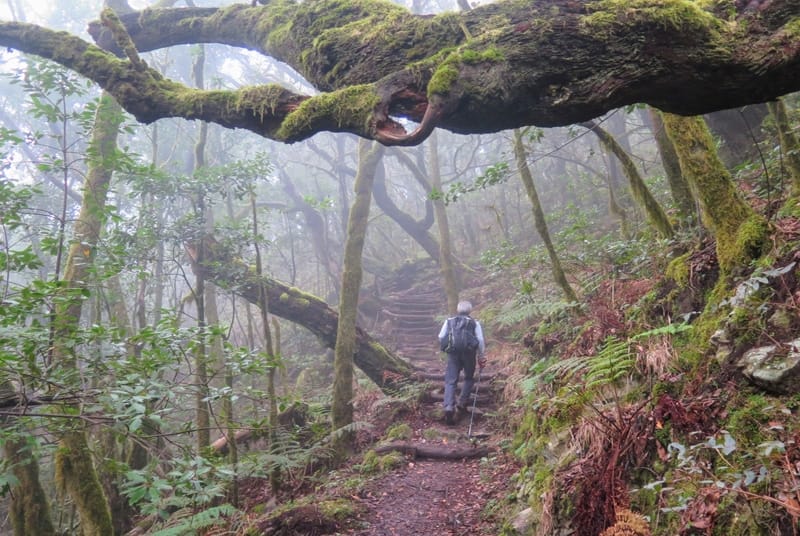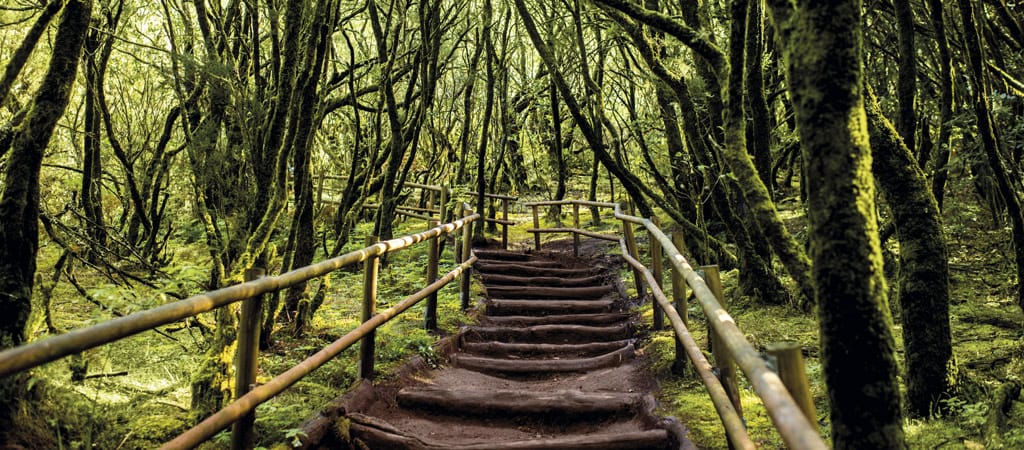If you are looking for a holiday destination with a great diversity in nature and where to practice hikingThe Canary Islands should be your next destination.
The vast majority of the Canary Islands offer a wide range of activities to do in nature, and the ideal place to do them is in its laurel forests.
In this post I am going to show you a selection of the best Canarian laurel forests in the Canary Islands.
Canary Island Laurisilva
More than 20 million years ago, the Laurisilva forests covered much of the Mediterranean basin in the Tertiary period. However, due to glaciations in the Quaternary period, these subtropical forests moved to more temperate areas: the North Africa and the Macaronesian archipelagos.
We are therefore talking about a living relic for its survival throughout history.
Laurisilva refers to the term laurel forest. The Canarian laurel forest is a type of laurel forest found in the Canary Islands. humid subtropical forests and which is very present in a large part of the Canary Islands. It is made up of several lauraceous tree species which, together with the Fayal-Brezal, make up the Monteverde.
It is characterised by its deep soils y be located between 600 and 1,500 metres above sea level.Therefore, it is more present on the islands at higher altitudes. The environmental conditions for this type of forest are an average annual temperature of 15 to 20 degrees and rainfall of 500 to 1100 mm.
On the other hand, thanks to the "sea of clouds", a natural phenomenon created by the trade winds, causes this type of forest to form on most of the islands. The humidity generated by this phenomenon is beneficial for the Canary laurel forest, as the sea of clouds causes the soil to be soaked and dripping continuously.

This type of forest can be found mainly on four of the Canary Islands: Tenerife, La Gomera, La Palma and Gran Canaria.
Laurisilva forests in Tenerife
The island of Tenerife is the larger of the Canary Islands archipelago and presents a wide variety of protected areas and natural environments. It also has the highest point in Spain: on Teide peak.
The largest presence of laurel forests that you can find on this island is in the Anaga Rural Park and Teno Rural Park.
Anaga Rural Park
The Anaga Rural Park is located in the north-east of the island of Tenerife and covers an area of more than 14,000 hectares. As it is so large, it is shared by three municipalities on the island: Santa Cruz de Tenerife, La Laguna and Tegueste.
In this park you can find a large variety of viewpoints and trails or routes to do in the heart of nature. The starting point for most of these trails can be found at Cruz del Carmen.
Anaga presents the largest area of laurel forest in the whole of Tenerifewhich has been preserved thanks to the possession of a steep terrain and for its difficult access on foot (in several parts).

Once you enter this laurel forest, you will be able to contemplate different types of trees, such as the laurels, lichens, heathers, colchicum fern, lime trees, mountain ferns or vines. You can also see with your own eyes how a mist is gradually spreading across the roads.
It is also worth mentioning that, for the bird lovers or birdwatchersthe Anaga Park is one of the most important special protection area for birds. One of the most important for the biology of the park is the laurel pigeon, known as the "laurisilva pigeon". turquoise pigeon.
Note:
If you are passionate about hikingIn Cruz del Carmen you will find an information office with information about everything you have and can do in the park. One of the most famous trails is the Path of the SensesIt is characterised by its low level of difficulty and the use of our senses to get to know the nature that surrounds the path.
Which plan to follow on your holidays?
Don't miss the Experience The pharmacy of the Laurisilva
Enjoy the secrets of the medicinal plants found in the Laurisilva forest of the Garajonay National Park
If you want to live a unique and environmentally friendly experience, and also get to know the Garajonay National Park from the hand of an official guide, book your place on a guided tour
Teno Rural Park
The Teno Rural Park is located towards the northwest of the island of Tenerife, in the municipality of Buenavista del Norte. This park is located in a volcanic massif known as the Teno Massifwhich covers an area of a little more than 8 thousand hectares from the coast to the peaks.
This park has a wide variety of vegetationThe laurisilva forest on the highest peaks of the park stands out. One of the laurel forests that stands out in this park is the one known as Monte del Agua.
Monte del Agua is one of the most important laurel forests in the Teno Rural Park, which covers an area of around 800 hectares and which is located between 600 and 1,200 metres above sea level.

The laurel forest featuring Monte del Agua is the second most important of the whole island of Tenerife.It has a high ecological value due to the different species of flora and fauna it possesses.
This laurel forest can be found on the deepest slopes of the Los Cochinos, Bucarón and Cuevas Negras ravines.
One of the best hiking trails in the laurel forest itself is the Erjos circular path which joins up with the Portelas. Once you enter the woodland of this forest, you can enjoy its variety of shrubs, of which the most outstanding are the tabaibas and broom.
Laurisilva forest on La Gomera
La Gomera is one of the smaller islands of the Canary Islands archipelago, with a surface area of 369.76 km2. It is the ideal island for hiking, due to its great natural heritage.
On La Gomera the laurel forest is located in the Garajonay National Parkwhich covers an area of almost 4,000 hectares.
Garajona National Parky
The Garajonay National Park constitutes one of the most important natural parks in Europe with the largest area of laurel forestsThe declaration was protected under the declaration of UNESCO World Heritage Site in 1986.
The laurel forest found in this national park covers more than one hectare. 85% of the surface thereof. Here you will be able to see a large number of different plant species such as trees: laurels, persea vines, tile trees, wild olive trees, palos blancos and durillos.

Once you get into the forest you will also find a great variety of fauna, consisting of amphibians, reptiles, birds and insects. However, the most characteristic species of this laurel forest is the pigeon rabiche and the turquoise pigeon.
It should also be added that the Garajonay national park is the ideal place for connecting with natureThe large natural areas and the wide range of activitiesand the incredible viewpoints, paths and trails. from where you will be able to contemplate this authentic natural jewel.
By the way, don't miss my article about the Legend of Gara and Jonaywhich gives its name to this park.
Laurissilva forest on La Palma
The island of La Palma is the fifth largest island of the Canary Islands, with an area of 708.32 km2 In addition, the island is also known as the La Isla BonitaThe natural wealth of the area will amaze you as soon as you see it.
On La Palma, the greatest presence of laurel forest is found in the Las Nieves Natural Parkwhich occupies an area of little more than 5 thousand hectaresIt is the third largest natural park in the Canary Islands.
Parche Natural de Las Nieves
The Natural Park of Las Nieves covers an area that includes three municipalities of La Palma: Puntallana, San Andrés y Sauces and Santa Cruz de la Palma.
In the Bosque de los Tilos consists of the laurel forest of the island of La Palma. Due to the great natural heritage that it preserves, it was declared the first Biosphere Reserve in the whole of the Canary Islands.
Once you get into the Tilos' woodland, you will have the opportunity to contemplate a Canarian flora rich in trees and plants such as tile trees, palos blancos, laurels, vinatigos, strawberry trees, wild orange trees, barbuzanos, wild olive trees, fayas, heathers, woodwardia radicans, pear trees and giant ferns..
In this natural area you can find the Canal and Los TilosThe forests were declared a Biosphere Reserve by UNESCO in 1983.

On the other hand, by alluding to its fauna, you will be able to see and hear the rabiche and turquoise pigeons. As you can see, they are typical of these Canarian laurel forests.
Also, due to the characteristics of the island and its high presence of green natural resources, it is usually the island where there are more rainfall. This allows for the favourable conservation of this laurel forest and, taking this into account, we can find in its interior several natural waterfalls such as the one found in Los Nacientes de San Marcos and Cordero.
Laurisilva forest in Gran Canaria
Gran Canaria is the third largest island in the Canary Islands, with an area of 1560 km2. It is the ideal island for those who are looking for a good holiday. sun and beachwith its incredible dunes which are located in Maspalomas.
You will find the laurel forest in the Los Tilos de Moya Forest which are located in the Doramas Forest, Unfortunately, there are only small areas of laurel forest, as in the 19th century, large forests were cut down for timber.
Los Tilos de Moya Forest
The forest of Los Tilos de Moya is the last laurel forest reserve of Gran Canaria, due to the deforestation suffered in the Doramas Forest.
This laurel forest is located in the Moya Ravine has an extension of 91 hectares.
Taking into account the natural resources that this forest possesses, as well as a search for their correct conservation and preservation, it was granted the title of "Forest of the Forest". Los Tilos Special Nature Reserve.

Once you enter this forest you will be able to observe several endemic species of its fauna such as chaffinch, common buzzard, black-winged woodpecker, robin and kestrel.
In terms of vegetation, we can observe a large presence of lime trees, barbusans, bicacarous and cockscomb.
As you can see, the Canary Islands have a great rich natural heritage. Many who visit these spectacular laurel forests say that they remind them of the forests of fairy tales.
What do you think, have you already been on one of them, would you like to do a trail on them? Leave us a comment.



Add comment